DISCLAIMER
the content of these galleries is a private property
neither the text nor the pictures may be republished, nor used for any purpose, without the author's permission
special thanks to Jeff Hopewell, whose
knowledge of Ganjifa
has been a precious reference in the compilation of this gallery
Besides the Dasâvatâra and the Mughal Ganjifa
(including the "birds" variety), several other patterns exist, yet less common than the
two aforesaid ones. They feature specific themes with a various number of suits.
RASHI GANJIFA
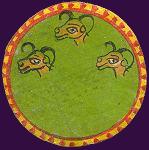
3 of Rams (Aries) |
Rashi ("zodiac") Ganjifa is a twelve-suited pattern that
features zodiac symbols as suit signs.
The Indian or Vedic zodiac is similar to the Western one: it divides the year into twelve
periods or "houses", each of which is identified by a symbol. However, the astronomic
reference of the Indian zodiac is the actual position of the constellations,
whereas the Western zodiac's cycle elapses from each year's spring equinox (March 21); this discrepancy between the two
systems, due to a certain variation of the Earth's yearly rotation (called "precession
of the equinoxes"), at present causes the Indian zodiac to be about 18 days
behind the Western one. |
How the periods are calculated, though, is of little importance for
the Rashi Ganjifa deck. The twelve symbols, instead, used as pips on the cards, are much more
pertinent: the following table shows a comparison between the Western and the Indian ones. |
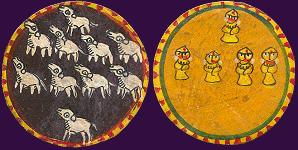
10 of Bulls (Taurus) and 5 of Virgins (Virgo) |
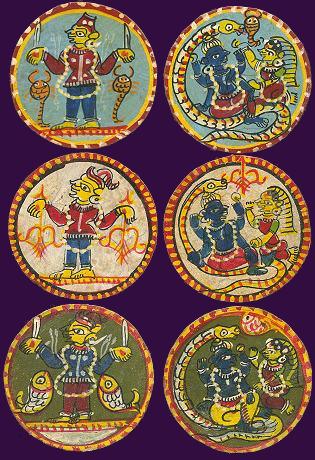
mantrî and râjâ cards of Scorpions (Scorpio),
Bows (Sagittarius) and Fishes (Pisces)
|
| WESTERN ZODIAC | INDIAN ZODIAC |  |
|---|
| Aries | Mesha | ram |
| Taurus | Vrishaba | bull |
| Gemini | Mithua | couple |
| Cancer | Karkata | crab - circle |
| Leo | Simha | lion |
| Virgo | Kanya | virgin - daughter |
| Libra | Thula | scales - weight |
| Scorpio | Vrishchika | scorpion |
| Sagittarius | Danus | bow - weapon |
| Capricorn | Makara | water-dragon |
| Aquarius | Kumbha | pot - jug |
Pisces | Meena | fishes |
|
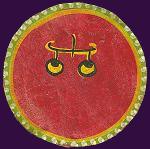
1 of Scales (Libra)
|
In this edition, from the city of Parlakhemundi (Orissa),
the personage of the mantrî card is featured holding a double suit sign, while
the râjâ card shows Vishnu and his wife Lakshmi resting on Shesha, the
mythical snake with a thousand heads (only one of which is seen in this representation);
an identical illustration is found in the Dasâvatâra "birds" pattern,
shown in page 3, from the same city. |
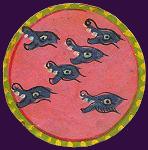
6 of Water-dragons (Capricorn)
|
NAVAGRAHA GANJIFA
Navagraha means "nine planets".
In Hindu culture, these planets are believed to bestow humans with special gifts,
and are worshipped as gods (specific prayers are recited to each of them).
In India this is an important cult; in fact, the Navagraha Ganjifa
pattern was created at the beginning of the 20th century by Shankar
Sakharama Hendre, whose project was to sell cards to raise enough money
for building a temple dedicated to the Nine Planets, in Bombay. Although
his goal was not achieved, the Navagraha Ganjifa survived.
|
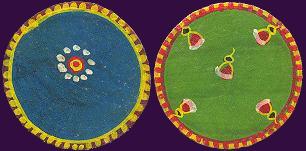
1 of Surya (Sun) and 5 of Chandra (Moon)
|
In this pattern each suit represents a planet; but the last two,
Rahu and Ketu, are actually lunar nodes, namely the ascending node and descending node,
respectively referred to as "dragon's head" and "dragon's tail", and often
pictured as a bodyless head and a headless body.

mantrî and râjâ cards of Sukrana (Venus),
Buddha (Mercury) and Ketu (Dragon's tail)
|
Each planet a is a deity itself, to which a month, a zodiac sign,
a colour, a gem and a steed are matched.
The table shows the full series of planets (some have alternative names,
according to the different parts of the country):
| DEITY-PLANET |  | DEITY'S STEED |
|---|
| Surya · Ravi | Sun | 7 horse-drawn chariot |
| Chandra | Moon | antelope-drawn chariot |
| Mangala · Kuja | Mars | buffalo · goat |
| Budhan · Buddha | Mercury | yali (lion with elephant's trunk) |
| Guru · Brihaspati | Jupiter | elephant · goose |
| Sukrana · Sukra | Venus | horse |
| Sani · Shani | Saturn | eagle · crow |
| Rahu | Dragon's head | (no steed) |
| Ketu | Dragon's tail | (no steed) |
|
|
This edition, from Orissa, features the same signs usually
found in the local Mughal pattern, plus an additional one made for this purpose,
since the Navagraha suits are nine.
For instance, the red shapes with a central striping on cards with a yellow background,
which in the Mughal pattern form the suit of Kumancha ("merchandise"), in this
deck represent the Mangala suit (Mars), but all in all they are the same graphic symbol.
And so on for the other suits.
|
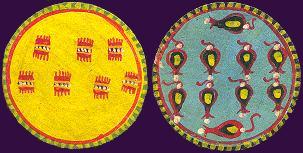
7 of Mangala (Mars) and 10 of Buddha (Mercury)
|
The only relation with the planets can be found in
the highest courts, the râjâ cards, that feature the planet-deity
as a human figure together with his own traditional steed, on which the identification
is also based, see the previous table.
In Navagraha decks made in other parts of India, instead, also the signs of
pip cards are different from those of the Mughal sets.
Besides the Ganjifa varities mentioned so far, some others
exist: the Ramayana Ganjifa,
a twelve-suited pattern inspired by the Sanskrit epic Ramayana, the
Ashtamala Ganjifa, inspired by eight episodes of
Krishna's life as a youth, and the Ashtadikpala Ganjifa which
refers to the eight cardinal directions.
OTHER GALLERIES






















or back to

INTRODUCTION
AND HISTORY
|

MULTI-LANGUAGE
GLOSSARY |

THE FOOL &
THE JOKER |

INDEX
TABLE |

REGIONAL
GAMES |

PLAYING CARD
LINKS |
